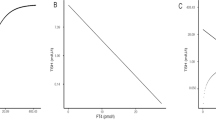Abstract
Several alternative models of the system regulating the plasma concentration of thyroid hormones are presented and investigated from the point of view of certain optimal system performance indices. The models differ from each other in the number and types of feed-back pathways. Various combinations of thyroid hormone feedback actions at pituitary and/or hypothalamic chemoreceptor sites, having proportional and/or rate characteristics, are considered in terms of minimum energy consumption and minimum sensitivity to the maximum number of model parameters likely to vary. It is concluded that the model which includes proportional inhibitory feedback of thyroid hormone at the hypothalamic level and rate feedback of thyroid hormone at the level of the pituitary provides the best performance.
Similar content being viewed by others
Literature
Brown-Grant, K. 1967. “The Control of Thyroid Secretion”.J. Clin. Path., Suppl.20, 327–332.
DiStefano, J. J., A. R. Stubberud and I. Williams. 1967.Feedback and Control Systems. New York: Schaum.
— and E. B. Stear. 1968. “Neuroendocrine Control of Thyroid Secretion in Living Systems: A Feedback Control System Model”.Bull. Math. Biophysics,30, 3–26.
Escobar del Rey, F. and G. Morreale de Escobar. 1964. “The Peripheral Deiodinatation of Thyroid Hormones and Some Metabolic Implications.”Proc. 2d. Intl. Congr. Endocr., London, Experpta Medica Intl. Congr.No.83, pp. 1151–1167.
Reichlin, S. 1966. “Control of Thyrotropic Hormone Secretion”. InNeuroendo-crinology, L. Martini and W.F. Ganong, Eds. New York: Academic Press, pp. 445–536.
—, E. M. Volpert and S. C. Werner. 1966. “Hypothalamic Influence on Thyroxine Monodeiodination to T3 by Rat Anterior Pituitary Gland”.Endocrinology,78, 302–306.
Robbins, J. and J. E. Rall. 1967 “The Iodine Containing Hormones”. InHormones in Blood, Vol.1, 2d. ed., C. H. Gray and A. L. Bacharach, Eds. London: Academic Press, pp. 383–490.
Yates, F. E. and R. D. Brennan. 1967. “Study of the Mammalian Adrenal Glucocorticoid System by Computer Simulation” Technical Report No. 320-3228, IBM Data Processing Division, Palo Alto, California. (December) p. 37.
Author information
Authors and Affiliations
Rights and permissions
About this article
Cite this article
Distefano, J.J. Hypothalamic and rate feedback in the thyroid hormone regulation system: An hypothesis. Bulletin of Mathematical Biophysics 31, 233–246 (1969). https://doi.org/10.1007/BF02477003
Received:
Issue Date:
DOI: https://doi.org/10.1007/BF02477003




